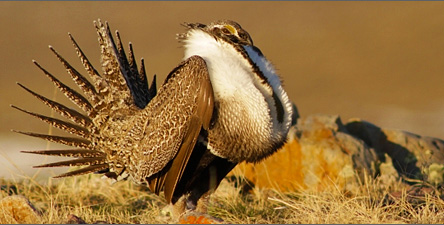Vilsack announces commitment to greater sage-grouse
June 20, 2014 | 04:15 PM
 The Greater Sage-Grouse (Centrocercus urophasianus) is a large chicken-like bird with a spiky tail. Its habitat is open sagebrush and grassland country. (USDA Natural Resources Conservation Service)
The Greater Sage-Grouse (Centrocercus urophasianus) is a large chicken-like bird with a spiky tail. Its habitat is open sagebrush and grassland country. (USDA Natural Resources Conservation Service)Agriculture Secretary Tom Vilsack today announced what he called “a ground-breaking commitment” from USDA to save the greater sage-grouse population that lives along the border of Nevada and California.
The announcement comes at the conclusion of an extended public comment period on the U.S. Fish and Wildlife Service proposal to federally list the bi-state population of greater sage-grouse as a threatened species under the Endangered Species Act.
A final decision on the proposal is expected by April 28, 2015.
Farm leaders and energy company executives have said that the listing could wreak havoc with their businesses.
USDA officials have said repeatedly they want to help landowners avoid that listing if possible.
“With proactive conservation investments, we’re helping farmers and ranchers who are improving habitat through voluntary efforts to stabilize this population of sage-grouse,” said Vilsack.
“Through action such as this, along with the support of our partners, we can help secure this species’ future and maintain our vibrant western economies.”
USDA will provide up to $25.5 million of conservation investments over the next five to 10 years as part of its contribution to delivering the federal, state and local 2012 Bi-State Action Plan, a conservation strategy that will benefit the sage-grouse population in both states, the department said in a news release.
The plan, sanctioned by the Interior Department’s U.S. Fish and Wildlife Service, aims to focus resources on cost-effective and efficient solutions that could avert the need to list the bi-state population as “threatened” or “endangered” under the Endangered Species Act.
Today, the Interior Department’s Bureau of Land Management (BLM) also announced a $6.5 million commitment over the next 10 years to implement a wide range of priority conservation activities on the public lands it manages to improve sage-grouse habitat, USDA said.
The BLM is coordinating with the U.S. Forest Service, a USDA division, to amend resource management plans that will include standards and guidelines designed to conserve and enhance sage-grouse habitat.
"We have made it a high priority to engage in voluntary partnership with ranchers, farmers and other landowners to conserve the wildlife and habitat that are so important to our heritage and way of life," said Secretary of the Interior Sally Jewell.
“I applaud the NRCS, USFS and the BLM for their very significant commitments, which will help provide certainty that important conservation actions in key areas of the bird's habitat will continue to be implemented. Together, we can make our landscapes work for both agriculture and the bi-state sage-grouse.”
The U.S. Forest Service and USDA’s Natural Resources Conservation Service are leading the Sage-Grouse Initiative and will have the means to carry out conservation practices and policy changes agreed upon by the Bi-State Local Area Working Group in its action plan, USDA said.
Since 2010, USDA has already funded $27.5 million in efforts to address threats to the greater sage-grouse.
Conservation easements on private lands are keeping working ranches intact that provide important wetlands for growing sage-grouse broods while removal of conifers that have invaded sagebrush-steppe is restoring sage-grouse habitat on private and public lands, USDA noted.
▪ USDA Natural Resources Conservation Service — Sage-Grouse Initiative
▪ USDA — Assurance of Implementation of Bi-State Action Plan for Greater Sage-Grouse
▪ Sage-Grouse Initiative
▪ Department of Interior Bureau of Land Management — BLM Commitments and Assurances to Implement Formalized Conservation Efforts for the Bi-State Distinct Population Segment of Greater Sage-Grouse